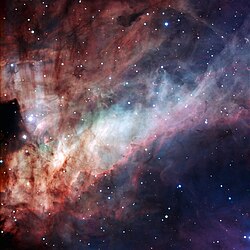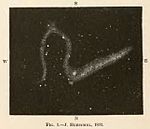Omeganebulosan
| Omeganebulosan | |
 Sammansatt foto taget vid La Silla-observatoriet | |
| Observationsdata | |
|---|---|
| Typ | HII-region |
| Stjärnbild | Skytten |
| Rektascension | 18t 20m 47s[1] |
| Deklination | -16° 10′ 18″[1] |
| Avstånd | 5 000 – 6 000[2] ljusår |
| Skenbar storlek | 46'×37'[3] |
| Skenbar magnitud | 7[3] |
| Fysiska egenskaper | |
| Radie | 8 ljusår |
| Upptäckt | |
| Upptäcktsår | 1745-46[4] |
| Upptäckare | Jean-Philippe de Cheséaux[4] |
| Andra beteckningar | |
| M17, NGC 6618 LBN 60, LBN 015.28-00.67, NGC 6618,[1] Sharpless 45, RCW 160, Gum 81 | |
| Se även: Nebulosor, Lista över nebulosor | |
Omeganebulosan, eller Messier 17 (M17) även känd som NGC 6618 är en nebulosa i stjärnbilden Skytten. Den består av en nebulosa och en öppen stjärnhop,[3] som är några av de rikaste stjärnfälten i Vintergatan. M17 upptäcktes av Jean-Philippe de Cheséaux 1745-46[4] och Charles Messier katalogiserade den 1764.
Egenskaper
Omeganebulosan ligger mellan 5 000 och 6 000 ljusår från jorden och har en diameter av ca 15 ljusår. Molnet av interstellära ämnen som denna nebulosa är en del av är ungefär 40 ljusår i diameter och har en massa på ca 30 000 solmassor.[5] Den totala massan av Omeganebulosan är uppskattningsvis 800 solmassor.[6]
Messier 17 anses vara en av de ljusaste och mest massiva stjärnbildande regionerna i vår galax.[5] Dess lokala geometri liknar Orionnebulosan bortsett från att den ses från kanten i stället för rakt framifrån.[7]
Den öppna stjärnhopen NGC 6618 ligger inbäddat i nebulositeten och får nebulosans gaser att lysa på grund av strålning från dess heta, unga stjärnor. Det faktiska antalet stjärnor i nebulosan är dock mycket högre - upp till 800 – varav ca 100 är av spektraltyp tidigare än B9 och 9 av spektraltyp O, plus över tusen stjärnor i formation i dess yttre regioner.[5] Den är också en av de yngsta kända stjärnhoparna med en ålder av 1 miljon år.[8]
Den ljusstarka blå variabeln HD 168607, i den sydöstra delen av nebulosan, antas i allmänhet vara förbunden med dess nära granne, den blå hyperjätten HD 168625, vilket kan vara så.
Galleri
- Omeganebulosa (vänster), Örnnebulosan (mitten) och Sharpless 2-54 (höger).[9]
- Gas- och stoftmoln med ca 15 ljusårs diameter.
- Del av nebulosan.
- En teckning av nebulosan av John Herschel 1833.
- Herschels andra teckning 1837.
- Omeganebulosa fotograferad av en amatörastronom. Inte relaterade stjärnor har redigerats ut ur fotot..
- Omeganebulosan.
Referenser
- Den här artikeln är helt eller delvis baserad på material från engelskspråkiga Wikipedia, Omega Nebula, 24 maj 2021.
Noter
- ^ [a b c] ”Basic data: M 17 – Open (galactic) cluster”. Centre de Données astronomiques de Strasbourg. http://simbad.u-strasbg.fr/simbad/sim-basic?Ident=Messier+17&submit=SIMBAD+search. Läst 5 april 2016.
- ^ Skär nebulosa med många namn, ESO, 23 september 2015
- ^ [a b c] Henriksson, Veikko (2005). Messierin kohteet. Ursa. sid. 44-45
- ^ [a b c] ”M17 på SEDS”. Arkiverad från originalet den 3 mars 2015. https://web.archive.org/web/20150303151007/http://messier.seds.org/m/m017.html. Läst 5 april 2016.
- ^ [a b c] Povich, M. S.; Churchwell, E.; Bieging, J.H.; Kang, M.; Whitney, B. A.; Brogan, C.A.; Kulesa, C.A.; Cohen, M.; et al. (2009). ”The Extended Environment of M17: A Star Formation History”. The Astrophysical Journal 696 (2): sid. 1278–1306. doi:. https://arxiv.org/abs/0902.3280.
- ^ ”Messier 17”. SEDS. 13 augusti 2007. http://messier.seds.org/m/m017.html. Läst 9 mars 2011.
- ^ . Broos, P. S.; Feigelson, E. D.; Townsley, L.K.; Getman, K.V; Wang, J.; Garmire, G.P.; Jhiang, Z.; Tsuboi, Y. (2007). ”The Young Stellar Population in M17 Revealed by Chandra”. The Astrophysical Journal Supplement Series 169 (2): sid. 353–385. doi:. https://arxiv.org/abs/astro-ph/0612590.
- ^ Hanson, M. M.; Howarth, I.D.; Conti, P.S. (1997). ”The Young Massive Stellar Objects of M17”. The Astrophysical Journal 489 (2): sid. 698–718. doi:.
- ^ ”VST Captures Three-In-One”. www.eso.org. https://www.eso.org/public/news/eso1719/. Läst 16 juni 2017.
Externa länkar
 Wikimedia Commons har media som rör Omeganebulosan.
Wikimedia Commons har media som rör Omeganebulosan.- Messier 17, SEDS Messier pages
- Omega Nebula at ESA/Hubble
- Omega Nebula (Messier 17) at Constellation Guide
| ||||||||
Media som används på denna webbplats
J. Herschel 1837
Författare/Upphovsman: European Southern Observatory, Licens: CC BY 4.0
Two of the sky’s more famous residents share the stage with a lesser-known neighbour in this enormous three gigapixel image from ESO’s VLT Survey Telescope (VST). On the right lies the faint, glowing cloud of gas called Sharpless 2-54, the iconic Eagle Nebula (Messier 16) is in the centre, and the Omega Nebula (Messier 17) to the left. This cosmic trio makes up just a portion of a vast complex of gas and dust within which new stars are springing to life and illuminating their surroundings.
Författare/Upphovsman: European Southern Observatory, Licens: CC BY 4.0
Three-colour composite image of the Omega Nebula (Messier 17, or NGC 6618), based on images obtained with the EMMI instrument on the ESO 3.58-metre New Technology Telescope at the La Silla Observatory. North is down and East is to the right in the image. It spans an angle equal to about one third the diameter of the Full Moon, corresponding to about 15 light-years at the distance of the Omega Nebula. The three filters used are B (blue), V ("visual", or green) and R (red).
J. Herschel 1833
Författare/Upphovsman: Pablo Carlos Budassi, Licens: CC BY-SA 4.0
Omega Nebula is one of the brightest and most massive star-forming regions of our galaxy 5500 ly away in the constellation Sagittarius - 15 light-years in diameter, 800 stars - The open cluster NGC 6618 causes the gases to shine - Only 1 million years old, it's one of the youngest clusters known -
Författare/Upphovsman: ESO, Licens: CC BY 4.0
This image of the rose-coloured star forming region Messier 17 was captured by the Wide Field Imager on the MPG/ESO 2.2-metre telescope at ESO’s La Silla Observatory in Chile. It is one of the sharpest images showing the entire nebula and not only reveals its full size but also retains fine detail throughout the cosmic landscape of gas clouds, dust and newborn stars.
The photograph, taken by NASA's Hubble Space Telescope, captures a small region within M17, a hotbed of star formation. M17, also known as the Omega or Swan Nebula, is located about 5500 light-years away in the constellation Sagittarius.
The wave-like patterns of gas have been sculpted and illuminated by a torrent of ultraviolet radiation from young, massive stars, which lie outside the picture to the upper left. The glow of these patterns accentuates the three-dimensional structure of the gases. The ultraviolet radiation is carving and heating the surfaces of cold hydrogen gas clouds. The warmed surfaces glow orange and red in this photograph. The intense heat and pressure cause some material to stream away from those surfaces, creating the glowing veil of even hotter greenish gas that masks background structures. The pressure on the tips of the waves may trigger new star formation within them.
The image, roughly 3 light-years across, was taken May 29-30, 1999, with the Wide Field Planetary Camera 2. The colors in the image represent various gases. Red represents sulfur; green, hydrogen; and blue, oxygen.![Omeganebulosa (vänster), Örnnebulosan (mitten) och Sharpless 2-54 (höger).[9]](http://upload.wikimedia.org/wikipedia/commons/thumb/7/77/The_VST_captures_three_spectacular_nebulae_in_one_image.jpg/150px-The_VST_captures_three_spectacular_nebulae_in_one_image.jpg)














